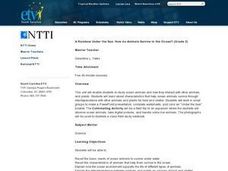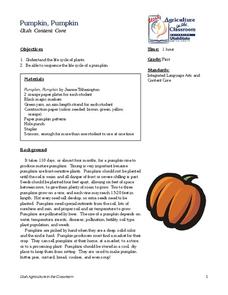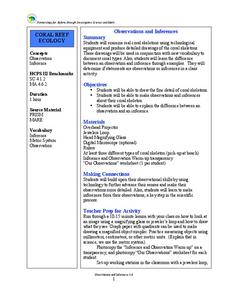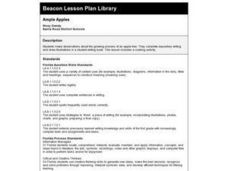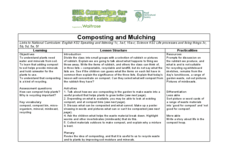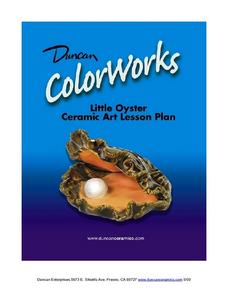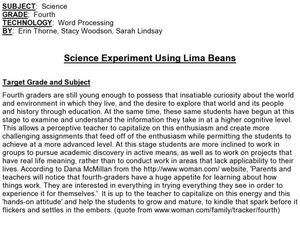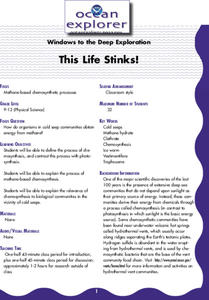Curated OER
A Rainbow Under the Sea: How do Animals Survive in the Ocean?
Second graders read books, watch videos, complete worksheets and participate in class discussions about ocean animals. They, in groups, design PowerPoint presentations on selected marine animals.
Curated OER
Interesting Insects
Students discover the characteristics of insects. They explore insects through cooperative learning, group projects, hands on activities, and poetry. They gain knowledge of insect life cycles, habitat, and physical characteristics.
Curated OER
Pumpkins, Pumpkins, Pumpkins
Students identify and interpret the lifecycle and parts of the pumpkin. Students utitlize interactive ways to discover this process. Students create a big book of their own by researching further information about pumpkins and what...
Curated OER
The Process of Scientific Experimentation
Pupils study scientific investigations. In this scientific method lesson students participate in a class discussion and watch a video.
Curated OER
The Radish Experiment
First graders grow radishes. In this Science lesson, 1st graders observe the growth of radishes in both the light and dark. Students discuss what plants need to live.
Curated OER
Is There Life Before 121?
Students observe microbial growth in the lab. In this biology lesson plan, students determine the conditions suitable for bacterial growth. They explain the methods of sterilization and bioburden testing.
Curated OER
Out of the Deep
Learners observe, describe, and record characteristics of ocean animals (mammals and fish) and sea shells. They conduct an experiment comparing and contrasting sugar water, salt water and fresh water and create a mural of coral reef...
Curated OER
Plant Life Cycle
Fourth graders explore the plant life cycle. They discuss the sequence of events in the life cycle of the plant and illustrate how the life cycle never ends. Students explore the importance of water, sunlight, and nutrients during the...
Alabama Learning Exchange
Peeking At Pumpkins
Students listen to a read aloud about the life cycle of the pumpkin and discuss the process. They complete a life cycle booklet.
Curated OER
Pumpkin, Pumpkin
First graders understand that pumpkins grow slowly over several months. In this pumpkin lesson, 1st graders listen to the book Pumpkin, Pumpkin and recall the sequence of the pumpkin life cycle. Students create pumpkin artwork showing...
Curated OER
Observations and Inferences
Students examine coral skeletons. In this science lesson, view real coral skeletons. Students explain the differences between an observation and an inference. Students draw a coral skeleton.
Curated OER
Ample Apples
First graders read stories and make observations about the life cycle of an apple tree. They write and illustrate expository text about apple trees and make applesauce.
Curated OER
Composting and Mulching
Second graders define composting and recognize what can be composted. In this composting and mulching lesson, 2nd graders classify objects or pictures as good or bad for composting. Students write a story about life in the compost...
Curated OER
Standard 4 Review Sheet-Key Ideas Biology-The Living Environment
In this living environment worksheet, students answer a variety of questions about living organisms, the processes they go through to make food and break down food, absorb nutrients, and release toxins. They explain homeostasis, they...
Curated OER
Math & Science
Young scholars examine a list of ideas to draw from for lesson planning. They complete a quiz on Math & Science and hand in notes they have taken as a resource for lesson planning. They develop developmental appropriate practice...
Virginia Department of Education
DNA Extraction from Strawberries
Has your class ever been astounded by the complexity of DNA analysis? Have they ever asked why genetic engineering has become so important to our daily lives? Young scientists perform DNA extraction on strawberries and explore how the...
PBS
Stories of Painkiller Addiction: Myth or Fact
Are opioids the most abused drug after marijuana? How hard is it for young people to obtain painkillers without a prescription? Middle and high schoolers explore the growing epidemic of opioid addiction with a lesson that prompts them to...
Virginia Department of Education
The Cell Cycle and Mitosis
What a packed instructional activity! Provide your class with the opportunity to learn about the cell cycle in several exciting ways. Biologists first learn about the theory behind mitosis, then proceed to view onion tips under the...
Curated OER
Little Oyster: Ceramic Lesson
Children will love researching and then creating a bottom dwelling mollusk of their own. They watch clips describing the ocean ecosystem and how oysters fit into their environment. Next, they research what oysters eat and how they look....
Curated OER
The Secret Life of a French Fry
Young scholars explore where the food they eat comes from. For this food lesson, students look at agriculture and food production. They follow the production of a french fry and discuss all the steps it goes through before being...
Curated OER
Science: Handwritten Personality
Young scholars watch an episode of "Frontiers" and discover the scientific basis for handwriting analysis. In the video, they discover how size, shape, and slant of handwriting suggest personality traits. After a discussion, students...
Curated OER
Science Experiment Using Lima Beans
Fourth graders tie together elements about the world and their environment. Students incorporate styles of higher order thinking skills. Students measure skills of observations, conclusions, inferences and predictions.
Curated OER
This Life Stinks!
Learners explore the process of chemosynthesis and contrast this process with photosynthesis. They consider the relevance of chemosynthesis to biological communities in the vicinity of cold seeps.
Curated OER
The "Coal LIfecycle" Scrapbook
Students discover how coal is formed. In this science lesson, students create a scrapbook on the life cycle of coal and show how coal is formed by showing pictures of each stage.


